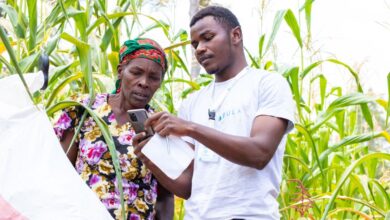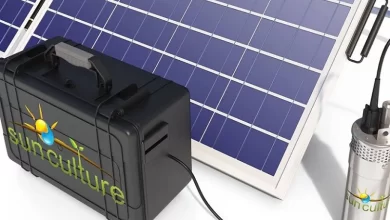Weekend Feature – Agritech Africa – Emerging Trends

1) Introduction
The Agriculture theme for April continues this weekend by looking at Agritech’s emerging trends, and the short to medium term future of Agritech and investment potential in Africa.
In last weekend’s article, from a funding and investor point of view, we presented data indicating that Agritech, registered just 5.6% from a total pool attributed to African startups that raised $1million and above in funding by 2019. And though Agriculture is largely unexploited, it represents a crucial frontier and platform for growth that remains at a stage of infancy in terms of utilisation on the continent.
Up to 2019, significant investments included Grainpulse $11m & Twiga Foods $30m. Indicating the diverse prospects available, we also had varied investments into – We Farm ($20.9m) – A.I -powered learning and knowledge-sharing platform used by more than 660,000 small-scale farmers across the world, including East Africa countries Tanzania, Kenya, and Uganda; Aerobotics into Geospatial Intelligence for Farmers (at least $2.7m) in funding; FarmDrive – credit scoring system that links local financial institutions with eligible farmers for issuing loans); Apollo Agriculture ($1.6m raised) raises farmers profits via machine learning, remote sensing, and mobile phones technologies.
Private-sector companies can find practical solutions to enter and grow in Africa’s agricultural market through Agritech according to McKinsey. McKinsey also estimates that Africa could be 2 or 3 times more productive if it intensifies its agric productivity. This strong correlation in modern times rests crucially on technology.
2) Emerging Trends
Though often considered to be rather traditional, agriculture is well on its way to turning into a high-tech industry, as advancements in machinery and a growing number of startups continue to improve. New concepts like smart & precision farming, crop efficiency, and vertical farming bring a breath of fresh air to this field, leading to what is called Agritech or, in some cases, AgTech.
A growing population, climate change, urbanization, and globalized trade are a few of the megatrends that impact agriculture and are approached with observational satellites and analytical software among others. In 2017, Agritech funding reached a record high of $10.1 billion globally.
- Snap-shot of Funders & Investors
Some investors and funders that have participated in the African Agritech space include; True Ventures LocalGlobe, Norrsken Foundation, Accelerated Digital Ventures, Devenish Investment, AHL Venture Partners, Consonance Investment Managers, GMSA Ecosystem Accelerator, Small Foundation, Novastar Ventures, Goldman Sachs, Draper Richards Kaplan Foundation, Y Combinator, Ventures Platform, Goldman Sachs, TLCom Capital, and French private equity fund – Creadev.
GFA assesses that this list will continue to grow as stakeholders in the value chain become more integrated, developing more recognisable and dependable infrastructure and systems, while reducing potential risk for financial investors. This is especially crucial in the last mile, where a significant proportion of Africa’s agricultural output comes through smallholder farmers.
- Role of Disruptive Agric Technologies
The agri-food system is characterized by several challenges which impede its ability to achieve a higher growth trajectory and to generate greater agri-food outcomes. First, the agri-food system is large and complex, with many dispersed actors and farmers in remote areas. without access to the emerging trillion-Dollar agrifood market. Second, vast inefficiencies in resource use and market access exist. Smallholder farmers struggle to connect with input suppliers. Third, Africa’s food system is characterized by inequalities in access to technologies, information, and markets.
Disruptive Technologies have the potential to help address many of the above challenges, and exist in agriculture consisting of digital and technical innovations that enable farmers and agribusiness entrepreneurs to leapfrog current methods to increase their productivity, efficiency, and competitiveness. This facilitates access to markets, improving nutritional outcomes and enhancing resilience to climate change. Agri-tech solutions range from mobile apps to solar applications, to portable agriculture devices, to bio-fortified foods.
Disruptive agricultural technologies differ from other agri-tech solutions in that they empower farmers by either (i) accelerating agri-food outcomes by multiple folds (3-5x) and/or by (ii) circumventing the conventions of the value chain to achieve the same/better results — but with a more efficient agri-food outcome.
First, disruptive technologies help farmers by reducing the costs of linking various actors of the agri-food system both within and across countries through providing, processing, and analyzing an increasing amount of data faster. Second, it helps farmers make more precise decisions about resource management through accurate, timely, and location-specific price, weather, and agronomic data – all types of information becoming increasingly important in the context of climate change.
Thirdly, these technologies can make smallholders and especially marginalized farmers more competitive by leveling the playing field. Even in poorly-connected rural contexts, or with marginalized groups who have lower access to information and markets, sophisticated off-line digital agricultural technologies can provide opportunities to help poor and even illiterate farmers. In short, Disruptive Agricultural Technologies are overturning the sector status quo, providing an innovative approach to addressing system-wide challenges
The creation of solutions to these system wide challenges, provide a fertile ground for innovation, entrepreneurship and funnels for investments.
3) Coordinated Investment Key To Growth
According to a report by Disrupt Africa, more than US$19 million in financing got funnelled into Africa’s agri-tech market over the two years preceding 2019.
But the organisation’s co-founder, Tom Jackson, says more is needed. “Most services are priced for smallholder farmers, as they comprise the majority of the market. However, they need to reach scale in order to make money themselves and become sustainable.”
Indeed, the vast majority of start-ups in this sector struggle to achieve economic and operational sustainability, says Michael Hailu, director of the Technical Centre for Agricultural and Rural Cooperation (CTA).
He points to CTA’s recent report finding that only 40 per cent of the 33 million African smallholder farmers who have signed up to agri-tech services are actually using them.
Part of this could be due to the short-term nature of donor support, which doesn’t allow enough time to adequately achieve scale or research and development.
“Governments, donors and investors can help by, for example, supporting better focus on understanding farmers’ needs, improved product design, and deeper research on business models,” says Hailu.
He also suggests measures that ensure agri-tech services are more affordable, including developing private-public partnerships and a continued push to business-to-business models.
However, he warns that without the right policy and investment, development of the sector may be fragmented. “We need to ensure coordinated development where best practices are shared and a collaborative approach to scaling up, focused on smallholders, is adopted,” he says.
4) Appetite for Funding Agric Startups – Experts’ Views
Former Twiga Foods Chief Executive Officer (CEO) Grant Brooke mentioned to Disrupt Africa, that the size of the market primarily accounted for the attractiveness of agri-tech startups.
“Agriculture is one of the largest, and most untapped by technology, sectors of the economy. I think investors are targeting agriculture because it’s a huge market, that touches just about everyone,” he said.
- A Sizeable Need
“Agri-tech is hot right now internationally, and Africa is no exception. Investment tends to be marco-economically stable, people have to eat, and there are a number of acquirers perusing the space lately looking for opportunities.”
“People have to eat” is exactly the view of Onyeka Akumah, co-founder and CEO of Nigeria’s Farmcrowdy, which allows users to sponsor farms and earn returns. Akumah believes people are beginning to pay attention to the growing demand for more food as Africa’s population grows.
“There is growing interest in funding for agri-tech startups that focus on the real problem of food security and enabling better use of technology to grow the agriculture sector as a whole. It is a welcome and attractive idea for investors,”.
Akumah said the potential for sizable returns for investors in agri-tech startups are as big as the market these startups play in. “There are different levels of the agriculture value chain, and depending on what sector a startup plays in, the investors they attract would have done their due diligence as to the market size,” he said.
Erick Yong’s company GreenTec Capital Partners is one such investor in Farmcrowdy, and also has a stake in Ghana’s AgroCenta, which connects smallholder farmers to a wider online market to trade, access truck delivery services and get real-time market information. He agrees that investors are flocking to the space due to its massive growth potential, and the fact it is currently very underutilised.
“On the one hand, more countries push for “home grown agriculture policies” as they look to slow down the import flow of agricultural products, thus increasing the internal demand for agriculture and agri services,” he said.
“On the other hand, the increasing use of tech applications, everything from soil testing and drone technology through micro-credit and micro-insurance availability, via mobile wallets and digital platforms, will greatly enhance harvest yields and the overall productivity of the agriculture sector as a whole.”
Wong said both these factors naturally increase investors’ appetites, encouraging them to try to realise the growth potential at an early stage.
“We believe some of the more scalable, digital platforms could run at 50 to 100 per cent annualised growth rates over the next three to five years as the market looks for winning, high growth business models” according to Yong.
As a result, a space that was previously the domain of impact-focused investors and donors is opening up to more return-oriented backers. Yong said while development finance institutions (DFIs) and non-governmental organisations (NGOs) continue to play a big role in financially supporting agriculture projects across Africa, there is a clear trend towards the emergence of private and return-driven investors.
Impact funds themselves are also changing. Brooke said the major shift he has witnessed is that impact funds are becoming much more commercial.
“I’m not sure there is a clear distinction between the two any longer,” he said. “That said, donors and social impact funds will continue to be the early-stage capital for agriculture startups. There isn’t much strictly commercial early-stage capital. But, as companies graduate up the funding ladder, we’ll see their capitalization tables get more and more commercial with each passing round.”
- Investment Needed To Scale
Whatever the type of investor the money is coming from, the fact that funding is on a meteoric rise is of crucial importance to agri-tech startups. Brooke says most agri-tech projects are a “scale game”.
“Funding is key for getting to scale. Further, as most models are new, funding is also needed to refine models, as we are just in the very early days on the continent of understanding what models are going to work in agri-tech,” he said.
Akumah agrees that startups relying on scale require serious funding in order to succeed. “When you tackle a big problem, you need the kind of backing that will allow you engage and successfully provide a solution for the big problem,” he said.
“Most startups solving big and real problems require funding to scale. The reason why the problem is big in the first place, speaks to why any startup looking to solve the issues would require resources, including funding, to tackle it properly.”
Yong, however, says this is not necessarily the case at the beginning of a startup’s journey. “In the very early stages, funding by itself is not the only ingredient for a winning recipe – successful entrepreneurs have to iterate and seek winning, profitable models,” he said.
Down the line, however, this changes. “Once unit economics and profitability is more visible, the funding to scale and grow becomes a lot more important. A startup’s proven ability to execute should be able to draw a lot more funding on the follow,” he said.
5) Conclusion
Smart farms are on the rise globally thanks to AI (Artificial Intelligence), IoT (Internet of Things) and big data analytics. Artificial Intelligence and Machine Learning are being used to provide growers with visibility, monitoring, and actionable analytics to optimize their farming. This data can then, for example, help build predictive models which can then be used to provide solutions such as predictive scheduling of fertilizer use. Drones are already being integrated to measure and monitor fields, create terrain maps, map fertilizer use, predict soil quality, and even plant seeds.
Agriculture is critical to some of Africa’s biggest development goals . The sector is an engine of job creation:
Whether it’s satellites that provide accurate climate data, Internet of Things devices like smart phones, or cutting-edge innovations like blockchain, technology could be a game-changer in boosting agricultural productivity and resilience in a sustainable way .
While agricultural productivity in Africa has picked up in recent years, it still lags behind other regions. In the coming decades, Africa’s food system will be further strained by a population that is projected to rise by 1.3 billion by 2050. The food security challenge will only grow as climate change intensifies, threatening crop and livestock production. If no adaptation occurs, production of maize—which is one of Africa’s staple crops—could decline by up to 40 percent by 2050. Expanding the land that is under cultivation has boosted African agricultural production in the past, but it has come at an environmental cost. Moving forward, the focus must be on intensifying production on agricultural land sustainably without harming the environment.
The focus must be on Agritech.
Referenced Articles: https://getfundedafrica.com/2020/04/10/april-10-references/
See links for feature weekend articles here:
1) Funding & Agritech in Africa…with a snapshot of 2019 https://getfundedafrica.com/2020/04/03/gfa-weekend-feature-funding-agritech-in-africa-with-a-snapshot-of-2019/
2) COVID-19…. Funding for African Businesses & The Opportunities https://getfundedafrica.com/2020/03/27/gfa-weekend-feature-covid-19-funding-for-african-businesses-the-opportunities-space/
GetFundedAfrica curates funding news across Africa and emerging markets. Subscribe for GetFundedAfrica Newsletters: https://getfundedafrica.com/pricing-plans/




